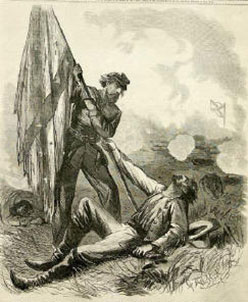
Please send all Checks and Money orders to :
Dave Taylor P.O. Box 87 Sylvania, OH 43560
419-842-1863
Click Here to E-mail Us!

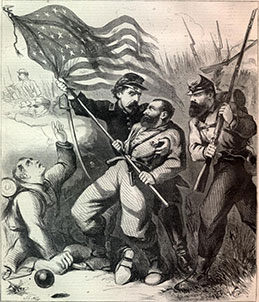
13 01 second list
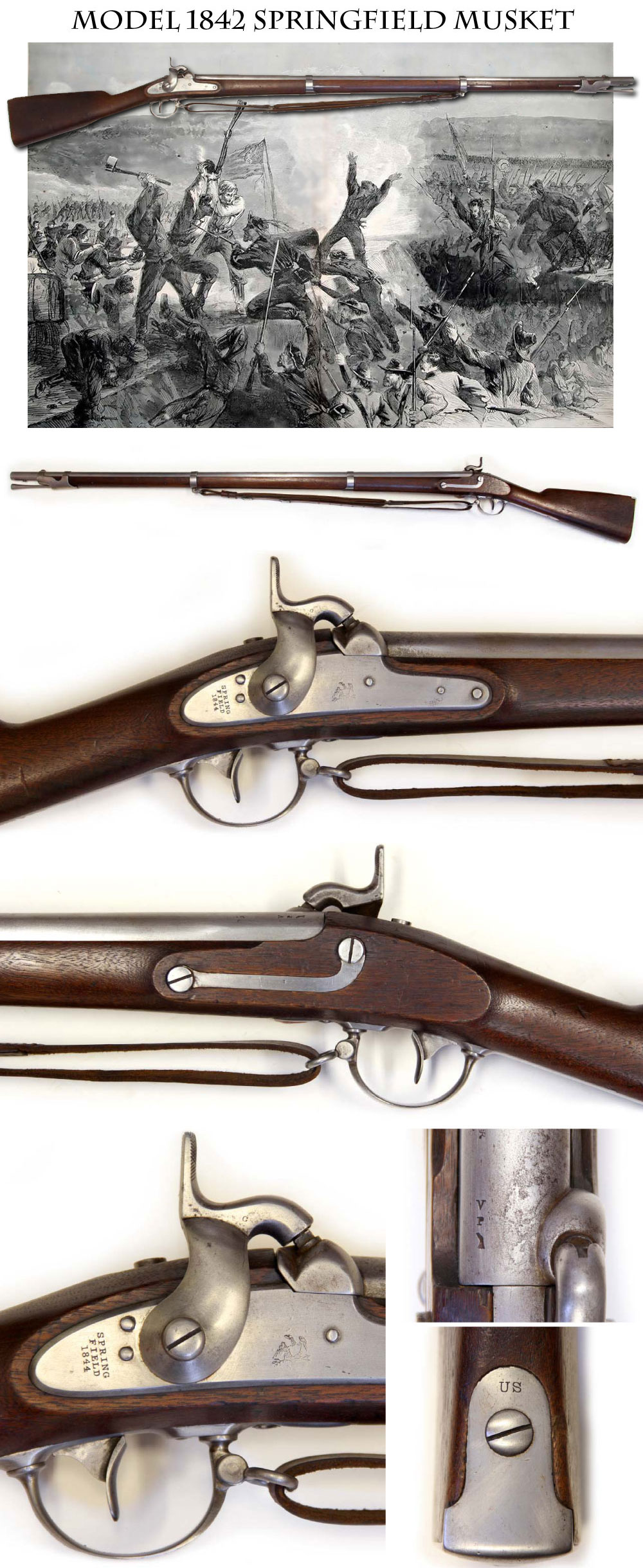
13-01-29 – Mexican War � Civil War Model 1842 Springfield Musket dated 1844:�
A very strong example of the large bore Model �42 and even more desirable with the Mexican War date of 1844.� Condition is Very Good to near fine.�� 100% original 100% complete and mechanically perfect.�� Stock is extra fine with sharp edges, pretty color, and no damage.� No cartouche marks which we see on about 50% of the Model 1842 muskets.�� The steel is uniformly burnished and very attractive.�� All metal stamps are crisp.� Lock is dated 1844, Springfield, eagle, etc��� barrel tang date is not present.� Barrel breech inspector�s marks V.P. over eagle�s head and inspector�s initials� A.R. over P.� These .69 caliber muskets were the last produced in the large bore size.� They were used heavily in the first two years of the Civil War by both Union and� Confederate infantry forces, and by the rebs for the remainder of the war as well.� Very nice condition. Comes with a modern rifle sling by Brauer Brothers in St. Louis which you could take off an put on your deer rifle.� You would probably pay $30 at Cabellas for this sling.����
$1,450.00 SOLD
Civil War style (rounded shoulder) Bayonet for the above musket, fine++ condition.
$295.00
Click Here to E-mail Us!
Call us @ 419-842-1863
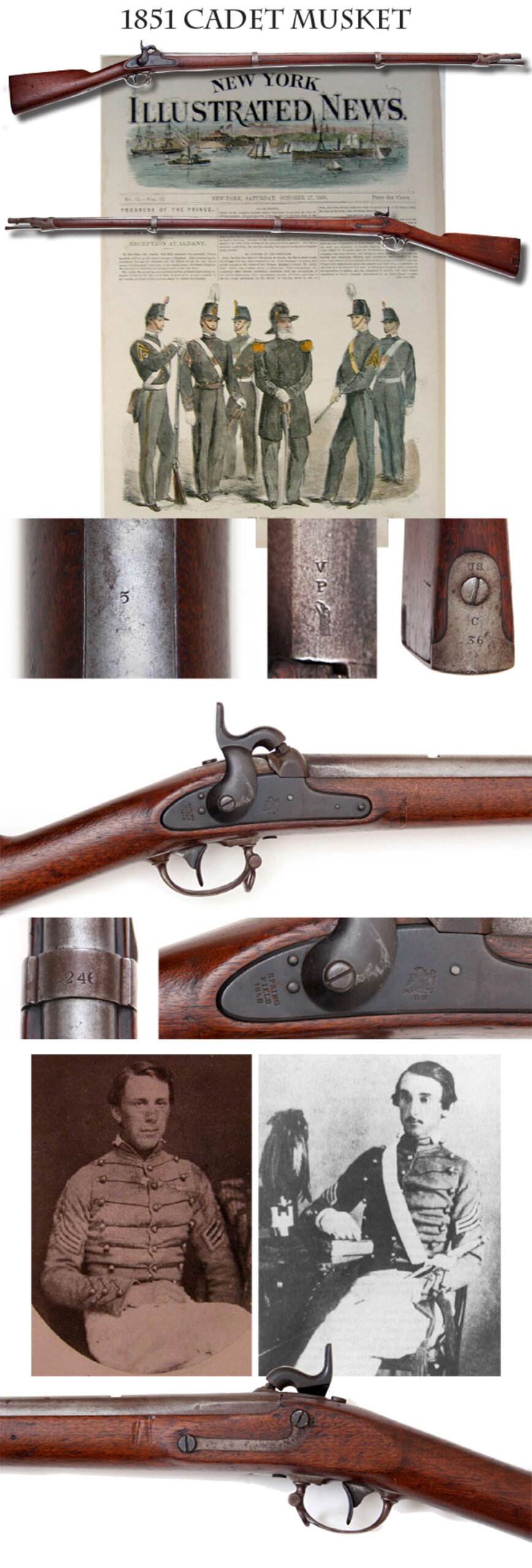
13-01-30 – Rifled & Sighted US Model 1851 Cadet Musket:�
This is one of the truly rare US martial muskets for the collector to obtain. It was manufactured at Springfield Armory for the use of the Cadets at West Point, and other military academies including VMI (Virginia Military Institute).� It is essentially a scaled down version of the Model 1842 US Musket but in .57 caliber instead of .69 caliber. Approximately 4,000 cadet �51s were produced in total,�
but ONLY 341 were rifled and sighted as this one is!
��Standard cadet muskets were produced between 1851 and 1853. Springfield production records indicate that 2,840 were produced in fiscal year 1852 (July 1, 1851 through June 30, 1852) and 1,160 were produced in fiscal year 1853 (July 1, 1852 through June 30, 1853). The use of the �fiscal year� production system at the national armories may explain the fact that 1-year date mismatches between the lock and barrel of a musket are not uncommon.� Of the above mentioned 4,000 muskets there were, according to Springfield Armory records, 341 of the muskets� altered to rifled muskets in 1857 by rifling them with 3 grooves and adding a long range rear site. This is one of the 341!��� The tip of the trumpet shaped ramrod was machined to concave in order to accept Mini� bullets.�� It is believed that all of the rifled and sighted arms were delivered to the US Military Academy at West Point for the use of the cadets.� Condition is Very Good ++.� 100% original and complete except for the rear sight which was removed for reasons unknown.��� The lock of the musket is clearly marked behind the hammer in three vertical lines: SPRING / FIELD / 1853, and is marked with an (EAGLE) / US forward of the hammer. There is no date on the tang. The breech is crisply marked with the usual Springfield Arsenal V / P / (EAGLE HEAD). The upper tang of the buttplate is marked with the usual�
US
�forward of the mounting screw, and is also marked with the rack number C/36 below the screw.� These rack markings appear to be standard on the �51 Cadets.�The middle barrel band is marked on the top �246� which may or may not be significant in terms of Springfield markings.� I do not know if the arsenal sequentially numbered the rifled muskets or if this is a later rack number. There is no wood cartouche and does not appear to have ever had one. (Same story on the only 1841 Cadet Musket I ever owned).� A darn rare US martial arm and very significant when one considers the cadets present at the USMA in the years immediately preceding the Civil War.� Undoubtedly this cadet rifle was used by one of the cadets that went on to become famous generals North and South.� A great rare weapon,�and one with clear historical connections ����
$2,750.00
Click Here to E-mail Us!
Call us @ 419-842-1863

13-01-31 – 1863 Pocket Testament:�
Classic Civil War testament as carried by hundreds of thousands of soldiers in both armies.� Published by the NY Bible Society and printed in 1863.� Bears a couple inscriptions pertaining to a Charles Henneday of Millersburg, Indiana� but I do not find our man listed as a soldier.� In fact the name is so unusual that I find no one with that surname. Overall good and solid with a leather repair on the spine.� Perfect for display with soldier�s effects or careful use in living history or reenacting.�
$75.00 SOLD
Click Here to E-mail Us!
Call us @ 419-842-1863

13-01-32 – Pennsylvania Found – Attic Condition Springfield Musket, Sling, and Bayonet:�
This rig is truly attic found.� I bought it from a general line antique dealer in Pennsylvania who got it �fresh out of the woods� as they say.� Musket is �very good� condition being 100% original and complete except for the rear sight screw is replaced and long leaf is missing from the rear sight (short leaf is present).� The most interesting aspect to this gun is that it has a Bridesburg contract lock (dated 1864) which has been in place forever… it is soldier incised with 1864 date� ��But the weapon itself is a Springfield Model 1863 Type-1 rifle musket. ��At some point an armorer somewhere replaced the Springfield lock with this Bridesburg contract example.��� This is the standard� �63 type one with screw bands securing the barrel and no band retaining springs.� Metal is overall age brown patina.� Lock markings are clear.� US� Bridesburg 1864.� Barrel breech markings are obscured under deep brown patina.� Bolster is the flat 1863 bolster with remnants of the stamped eagle.� One sub-inspector�s cartouche is visible on the left side of the stock.� The date 1864 is incised over where the ESA cartouche should be, and there are initials (possibly name too) incised near this date.� Small chip of wood gone near nose cap of no consequence.�� Has both sling swivels in place and still has the original harness leather Civil War rifle sling in place.� Also included is the matching and �always with it� regulation US socket bayonet with clear US stamp and identical patina as the gun.� I assume the Springfield lock that came in this musket broke or was lost and sometime in 1864 an armorer or the soldier replaced the lock with this Bridesburg example.� It would be no big deal just to drop in an 1863 dated Springfield lock�� but this gun surfaced with the Bridesburg lock in it and that�s the way I�m leaving it.��
$1,395.00 SOLD
Click Here to E-mail Us!
Call us @ 419-842-1863
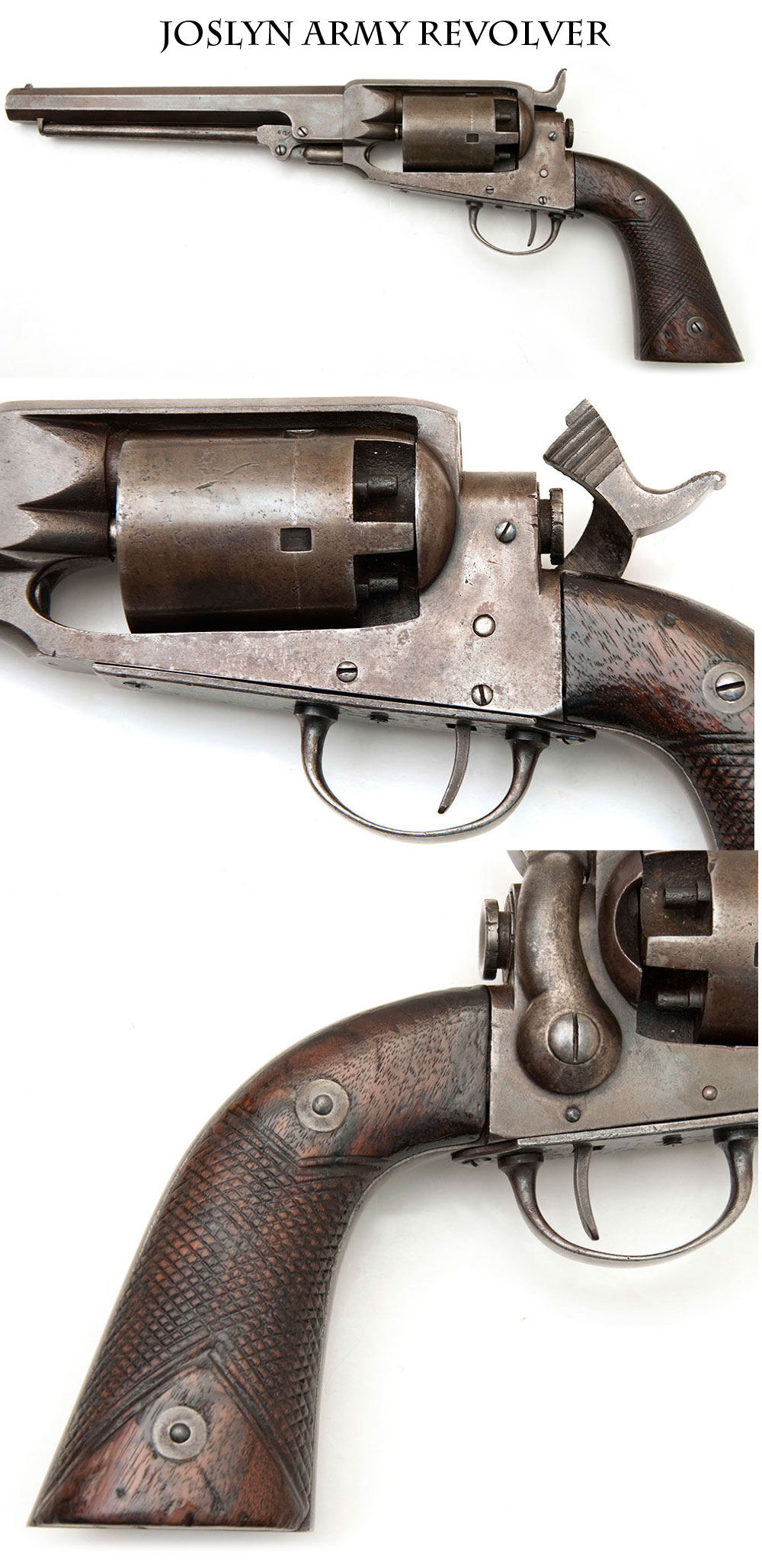
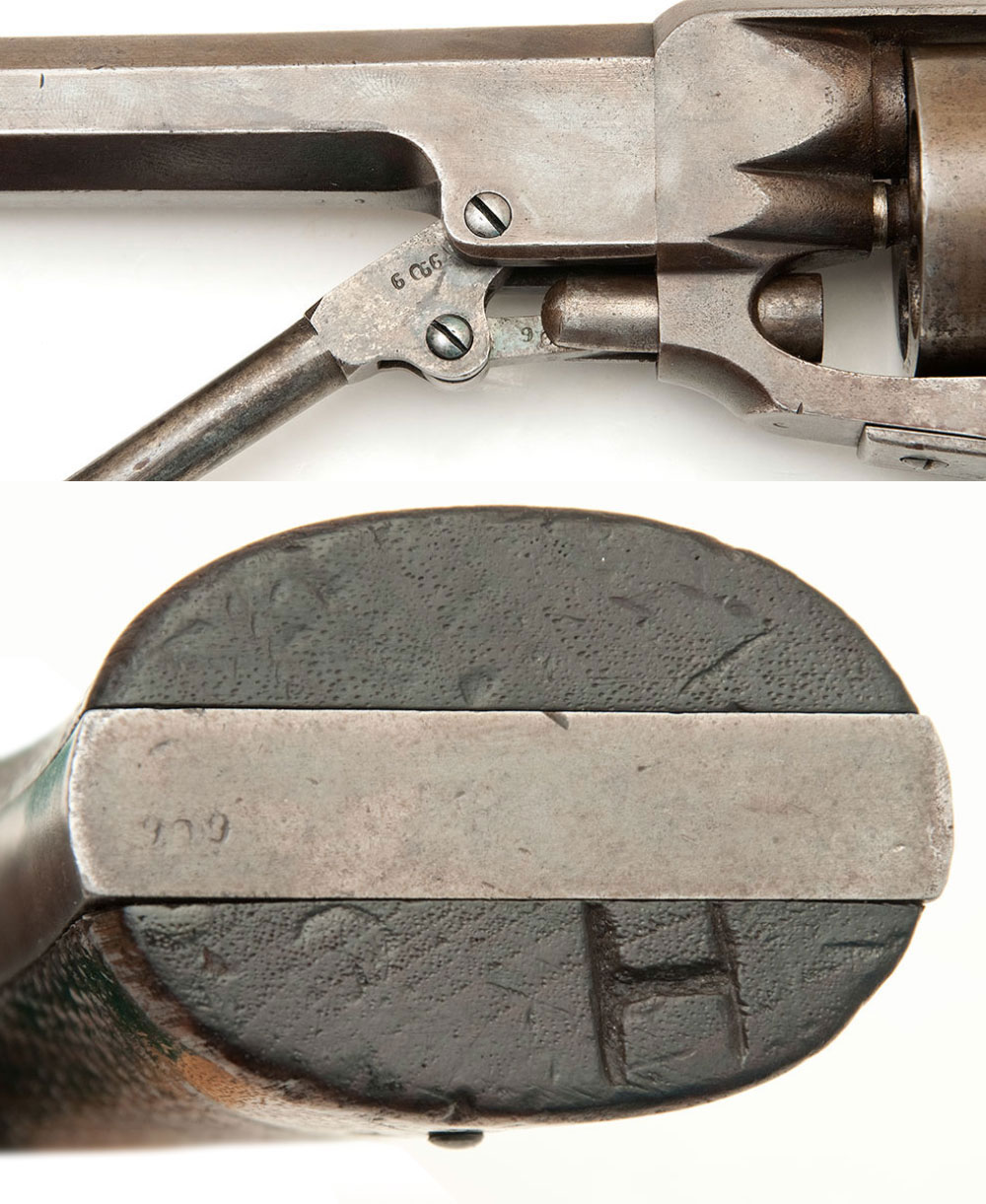
13-01-33 – Exceedingly Scarce Joslyn Army Revolver in near fine condition:
This is the Standard cavalry model produced by the Joslyn Firearms Company in Stonington, Connecticut. These were manufactured early in the war, circa 1861-1862, with about half produced under US government contract, and the balance state purchased. It is known that Ohio armed the 5th Ohio Cavalry with these elusive sidearms. This is a 44 Cal. 5 shot revolver with an 8 inch octagonal barrel. This example is in near fine condition with generous traces of original blue finish remaining in protected areas. The grips retain their factory checkering in good detail, and the butt has an “H” carved into it. Probably the soldier�s initial. The top of the barrel is stamped “B.F. JOSLYN / PATD MAY 4TH 1858” and the loading lever, butt, and barrel bear serial numbers 909 or 606 depending on how you read the numbers. This is an extremely scarce gun. Many collectors wait years to find one, and they seldom find one this nice.
$4,250.00
Click Here to E-mail Us!
Call us @ 419-842-1863
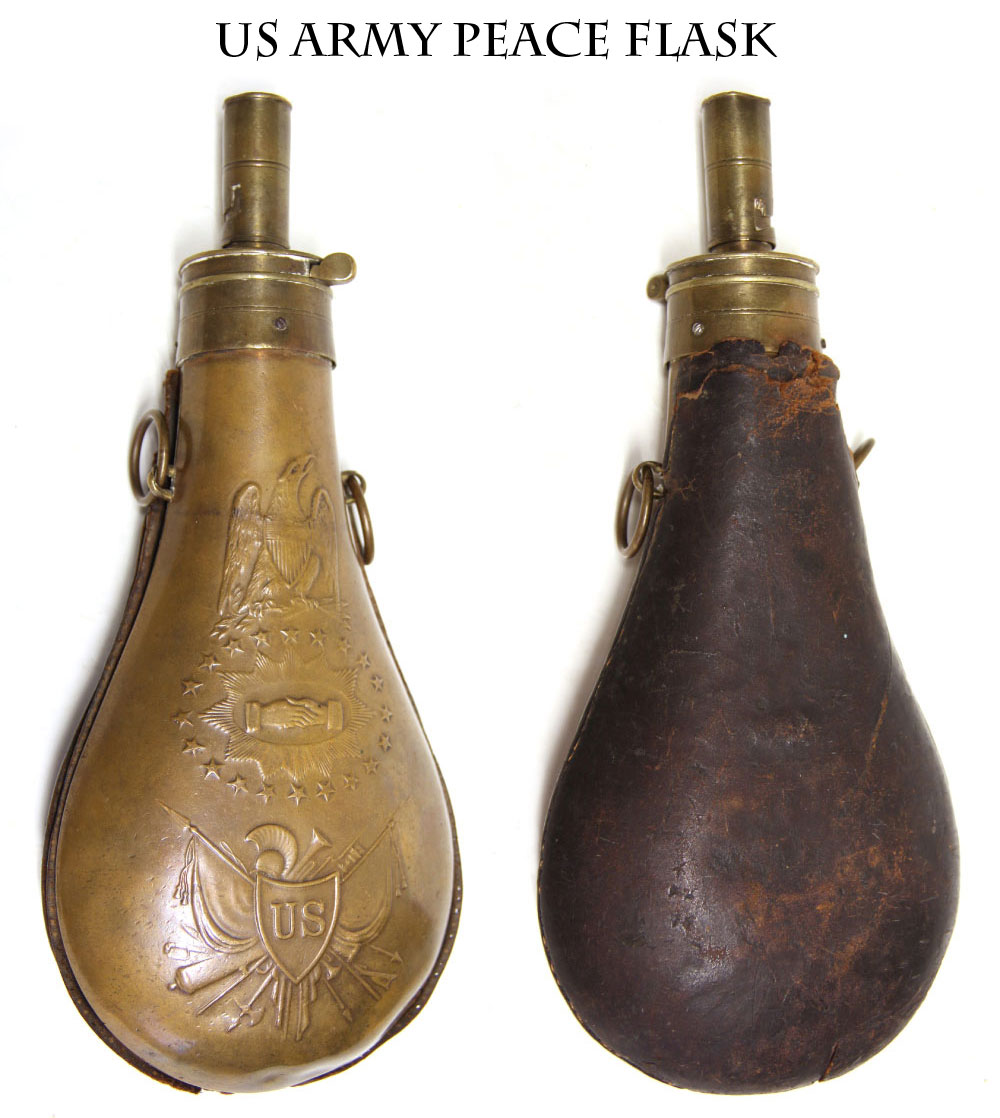
13-01-34 – Extra Fine Patriotic Brass Body US Army Peace Flask:
One of the great “finds” a collector can still make� a Peace Flask once disguised as a shotgun flask. When the Civil War ended there were a great many military Powder Flasks in the Peace-Flask designs available in surplus. Some enterprising gun dealers purchased the military flasks as surplus and covered them with leather to sell to sportsmen and hunters for use with shotguns. The leather covered flasks looked just like the quality gentleman�s flasks offered by the English Dealers. The flasks in question were standard issue US Army Peace-Flasks. The dealers simply changed the charging spouts on the military flasks to shotgun style, and then covered the patriotic embossed bodies of the flasks with a finely finished leather. This is exactly what we have here. This flask has an 1853 dated Batty contract top� a shotgun style charger� and a brass body with superb untouched age patina and wonderful patriotic motifs. The previous owner recognized what this was when he found it at a gun show. The seller just thought it was an old shotgun flask. My friend bought the flask and sold it to me. He removed the leather covering and we have kept it with the flask to show the interesting transformation. Fine early flask in excellent condition. Complete except the lever return spring on the charger is either broken or missing.
$295.00 SOLD
Click Here to E-mail Us!
Call us @ 419-842-1863
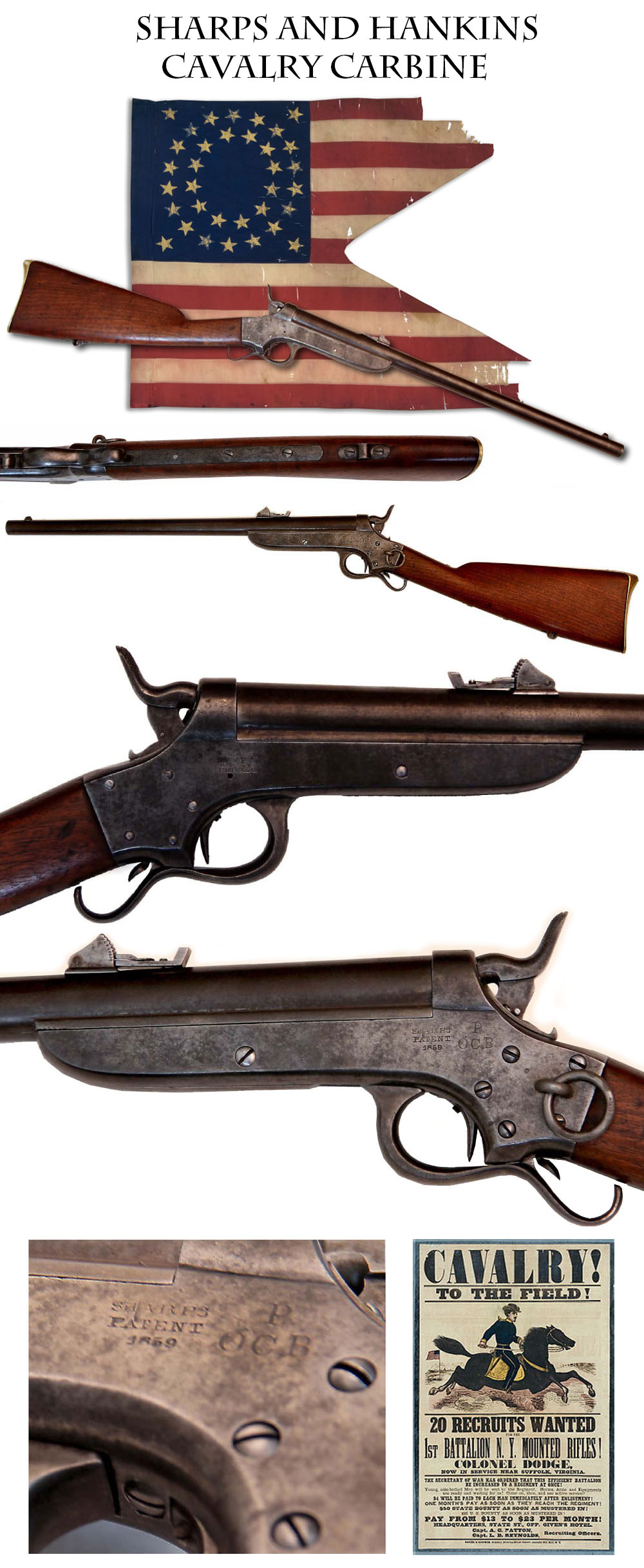
13-01-35 – 11th New York Cavalry � Scott�s 900 – Sharps & Hankins Cavalry Carbine w/ 19 Inch Barrel:�
One of the scarcer Civil War carbines is this product of the Sharps factories.� Only a thousand or so were produced in total and the bulk were issued to the 11th New York Cavalry.� This specimen is near “fine” condition� ultra handsome.� It is 100% original, 100% complete except for one swivel, mechanically new, and has a super bore. The swivel� base is present in the butt stock, only the swivel itself is gone and can be easily replaced.� It was undoubtedly removed as unnecessary since the gun has a saddle ring .�� Stock is very pretty with strong edges and beautiful color and luster.� Metal is a uniform light plum color with sharp markings. Has P over OCB inspector�s marks on the left side of the frame, and full firm markings on both sides.� Tight, solid,� and very appealing.
$2,350.00�SOLD
Here is a short history of the 11th New York Cavalry where this carbine likely saw service.
The 11th cavalry, “Scott’s 900,” recruited from the state at large, was organized at New York city, where the first ten companies were mustered into the U. S. service between Dec., 1861, and May, 1862, for three years.�
The regiment left the state on May 5, 1862, and served in the Military district of Washington, 22nd corps, a part of it being detached for service in the 8th corps, Middle Department, until March, 1864, when it was transferred to the Department of the Gulf.
During this period it was active in engagements at the Blue Ridge, Va.; Poolesville, Md., where it lost 4 wounded and 16 missing, among the latter being Lieut. William Smith; Fairfax Court House, Va., where a large part of a squadron under Maj. Remington was overcome by superior numbers and captured after a heroic resistance the losses being 3 killed, 15 wounded and 55 captured, though Maj. Remington succeeded in cutting his way out with 18 men.
It was also engaged at Bolivar Heights, Harper’s Ferry, Halltown, Edwards’ ferry, Leesburg and Rockville, but with slight casualties.� While in the Department of the Gulf it was engaged at New river, Manning’s plantation, Doyal’s plantation, where it sustained a loss of 2 wounded and 98 captured, Bayou Sara, Jackson and Clinton La., and at Brookhaven, Liberty, Franklin and Ocean Springs, Miss.
Early in 1865, it was transferred to the Department of the Cumberland and was engaged near Memphis, Tenn., in March, with a loss of 32 wounded, and at Germantown, Miss., in April, with a loss of 42 killed, wounded and missing.
The regiment lost altogether 1 officer and 22 men killed in action and died of wounds; 2 officers and 319 enlisted men died of disease, accidents, in prison, etc.; total deaths, 344.� It also lost a number of men by drowning, due to the foundering of the steamer North America off the coast of Florida on Dec. 22, 1864.
Great Civil War Carbine���
$2,350.00 SOLD
Click Here to E-mail Us!
Call us @ 419-842-1863

13-01-36 – Civil War Model 1850 Foot Officer’s Sword: �
The classic Civil War line officer’s sword – �the weapon carried by Infantry Lieutenants and Captains on the battlefield. �This specimen is ultra desirable as it has a steel “field scabbard” as opposed to the more common leather scabbard which deteriorates over time. �Has rich US and patriotic motifs etched into the blade. �Condition is overall VG showing just normal handling and wear.
Bargain priced at
$795.00 SOLD
Click Here to E-mail Us!
Call us @ 419-842-1863
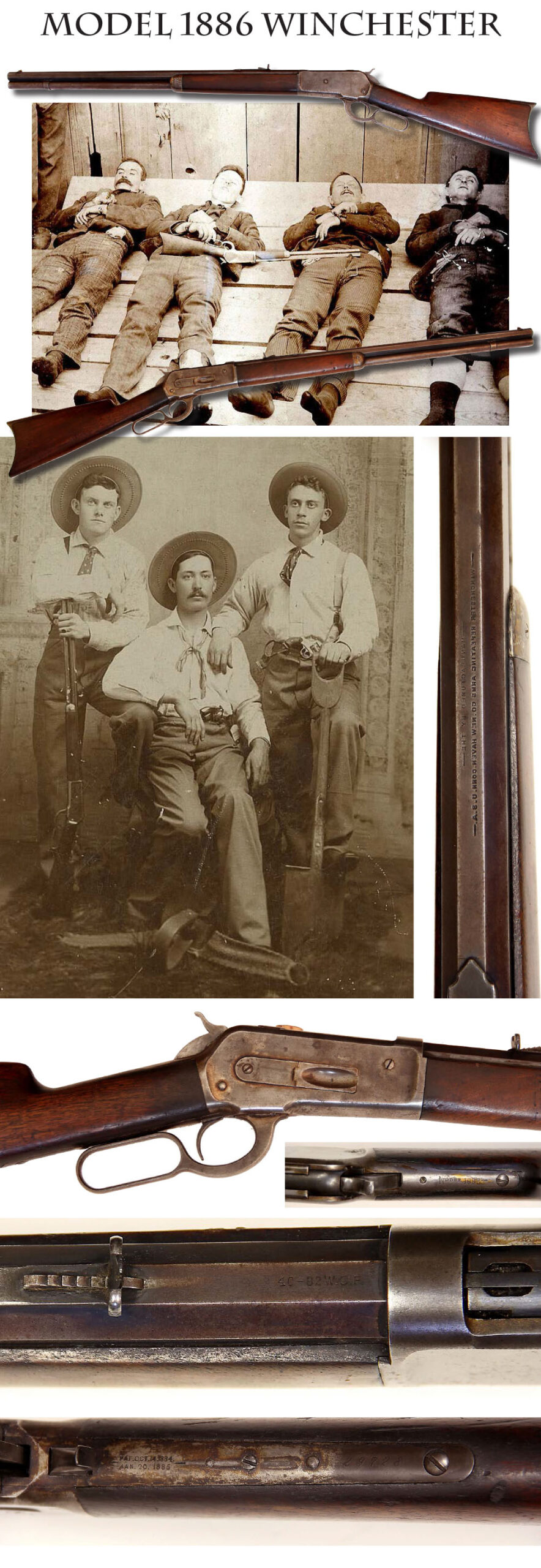
13-01-37 – Fine 1886 Winchester Rifle Manufactured in 1889:
Absolutely fresh to the market �attic found� condition. A more honest Wild West rifle you could not hope to find. Caliber 40-82. 26 inch octagon barrel. Generous traces of finish. Nice layers of dried nicotine and dried oil in protected areas. Absolutely �as found�. Super bore. 100% original and complete. Mechanically perfect. SN 29728. These 1886 rifles were carried by Lawmen, Cowboys, and Outlaws including the Dalton Gang and you can see one laid across their corpses in the photo shown here after their demise at Coffeyville, Kansas. Also shown here are three Cowboys — note the left hand subject proudly displays his �86. A great early Winchester at a very fair price.
$2,250.00 SOLD
Click Here to E-mail Us!
Call us @ 419-842-1863

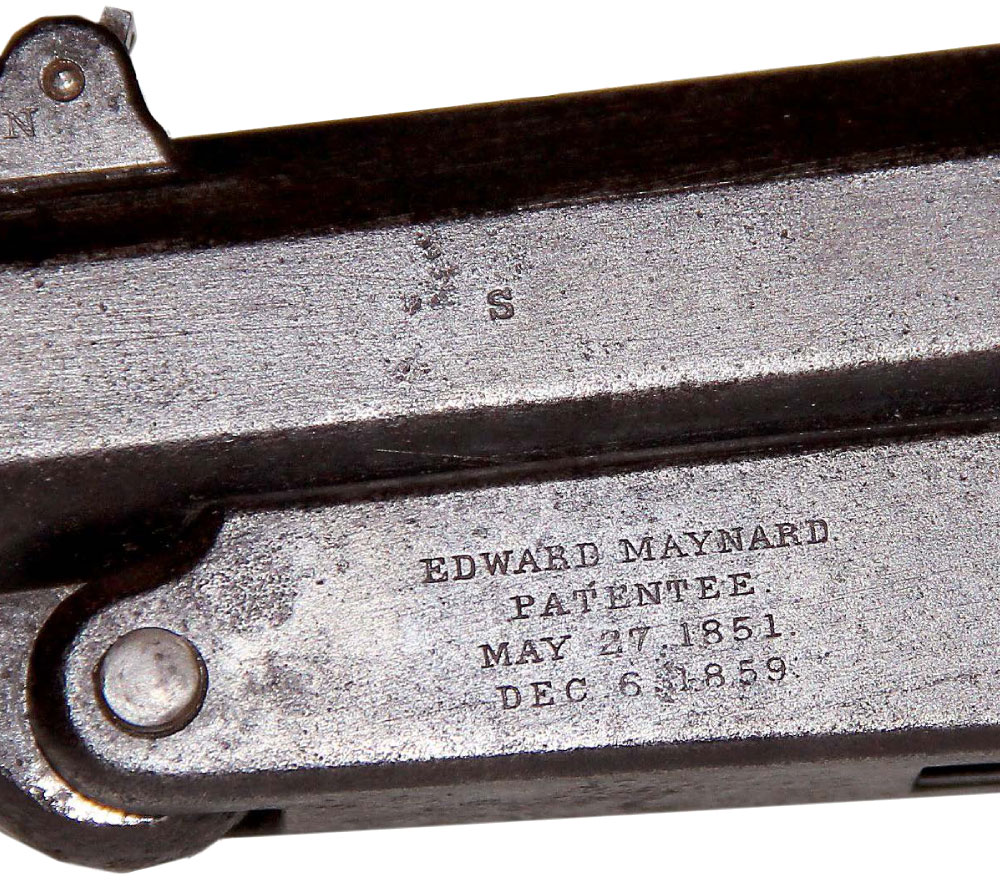
13-01-38 – Second Model Maynard Carbine:�
Overall very good condition.� 100% original 100% complete and mechanically perfect.� Bore is excellent.� Stock is fine with two sharp cartouches.� Metal is gun metal grey with some pitting near the muzzle.� All markings are sharp and legible.� SN 15852.� Good, solid, and affordable.�
$1,350.00 SOLD
Click Here to E-mail Us!
Call us @ 419-842-1863
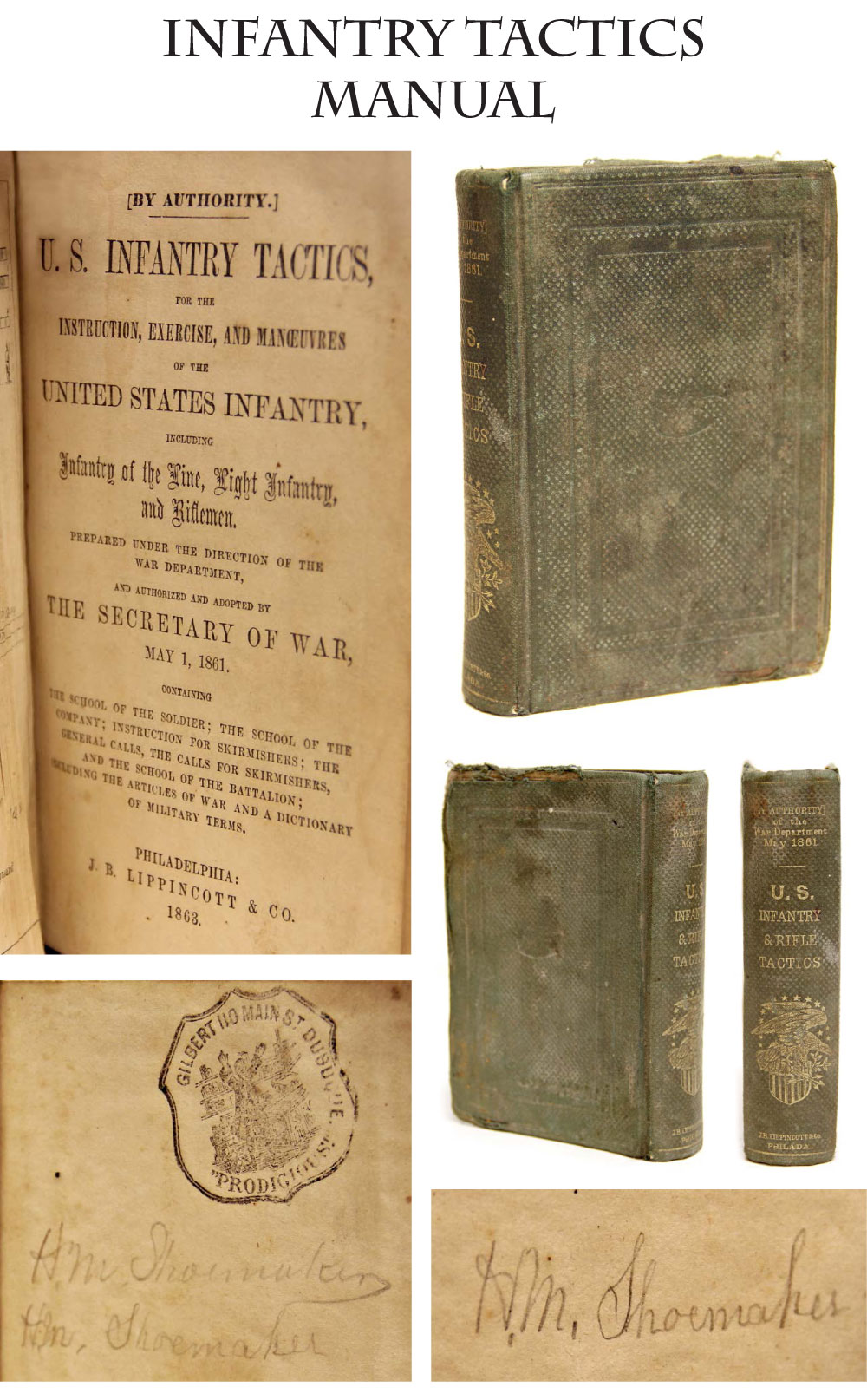
13-01-40 – 38th Iowa Officer’s Hardee’s Infantry Tactics Manuals: �
Here is the US Army’s version of Hardee’s Tactics printed in one volume by authority of the US War Department with no mention of Hardee who had cast his lot with the Confederates. � Printed by Lippincott / Phila. / 1863. Autographed inside the front cover is “H. M. Shoemaker”. �A quick check of the Civil War data base shows us that this is “Henry M. Shoemaker” Residence West Union Iowa 23 years old. �Enlisted on 8/11/1862 as a 1st Lieutenant. �On 11/4/1862 he was commissioned into Co. “F” �38th Iowa Infantry. �He was transferred out on 1/1/1865 �On 1/1/1865 he transferred into “K” Co. 34th Iowa Infantry. He was Mustered Out on 8/15/1865 at Houston, TX. Wounded 4/9/1865 Fort Blakely, Alabama. � Good solid condition showing just expected light handling wear. �A nice identified Civil War officer’s manual with excellent history. �
$235.00 SOLD
Click Here to E-mail Us!
Call us @ 419-842-1863

13-01-41 – Remington New Model Army Revolver and Holster:�
A very nice rig.� Revolver is VG plus condition.���100% original except for two replaced screws, (hammer screw and rammer screw).� 100% complete and mechanically perfect.��� Bore is excellent.�� Metal has a very attractive� patina� deeply aged brown� very rich.�� Markings are sharp and legible.� Serial number 38,226 is a very low number for a New Model.� The early examples, including this one, have the early Beals style cone front sight.�� Grips are fine to excellent with plainly visible inspector�s cartouche present.� This great old horse pistol comes with a marvelous full flap holster that is either commercial or Confederate.� It is a well designed harness leather holster constructed using only stitching, no rivets.� The front flap closed by means of the closing strap sewn to the front flap passing through a leather loop keeper, which is no longer present. You can see the stitching on the body of the holster where the loop was sewn.�� Holster is solid and pliable with some loss of finish which is well illustrated in the photos.� �Revolver is worth $1200� Holster is worth $500 I will sell the set for
$1,495.00 SOLD
Click Here to E-mail Us!
Call us @ 419-842-1863

13-01-42 – Civil War infantry accoutrements:
Nice, oval US plate on belt, canteen, cartridge box and cap box. Regulation issue 1858 pattern smooth-side canteen with all brackets in place, a short leather thong looped through one of them, and lots of the original tin plating on the body, which shows just minor dents and presses from 150 years. With this is a regulation issue arrow back oval US belt plate with all hooks intact, mounted on an altered US military NCO style waist belt originally having a rectangular plate. The adjusting hook, hasp and rivets holding it were removed and the oval US plate simply mounted on it. The cap box is in good solid shape and has had the inner flap removed as seen on many actually used examples. With this comes a model 1864 infantry cartridge box made and marked by Nece with a Sniffen inspector stamp, both tins and all straps and buckles in place, just a small hole in the outer flap to the left of the “US.” Inside the cover is a dead-real period ink identification inked by a soldier: “5 C 24 R.” I take this to be rack-number (i.e. the soldier�s roll number) 5 of Company C of the 24th Regiment. It could as well be “Fifth Company,” but I think it more likely the soldier�s number and company letter. There are a number of 24th Infantry regiments to choose from, but many of them may have been out of service by 1864 and it might be possible to narrow the list, but I leave that to the next owner. The 24th US Infantry was a “Colored” (African American) regiment� and is a possibility of which unit the marking represents. All the leather is solid and just shows minor, expected wear. It�s a nice group of gear to get a collector started or fill out that display. Heck, with the price I�m selling it at you could probably split it up and make money.
$765.00 SOLD
Click Here to E-mail Us!
Call us @ 419-842-1863
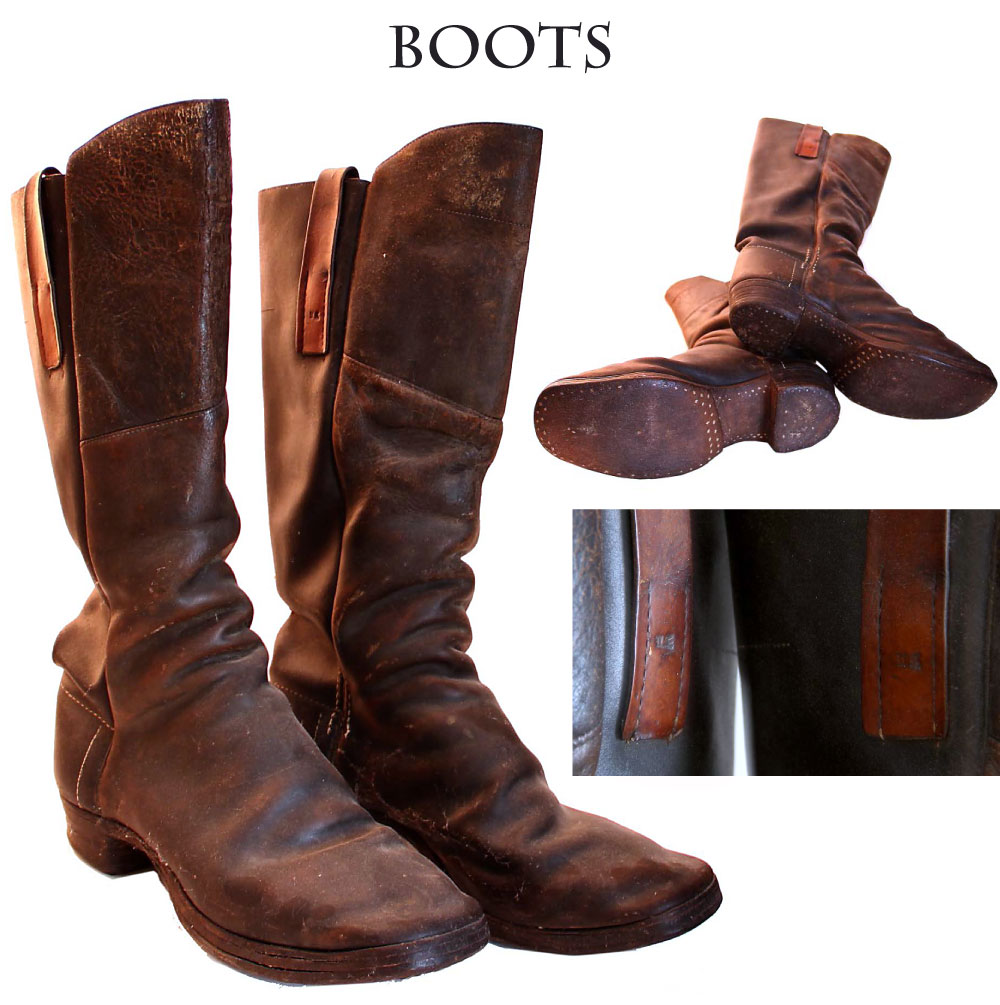
13-01-43 – Rare �US� marked Civil War boots:
Typical 1860s boots made with side seams and one piece fronts. The fronts are augmented with a grafted extension that reaches the knee and makes the front higher than the rear. This is the style used by mounted men in the cavalry and artillery. Has classic square toes, pegged soles, and nailed heels. Leather pulls sewn on each side of uppers, brown in tone from a different tanning process. This pair is very desirable as it is stamped with an Old English �US� on the lower part of each pull. I have seen the old English markings on the backs of US buckles, and some leather accoutrements , and I have read about cavalry boots marked �US�. But I have never owned a pair prior to now. Excellent condition. Probably a size 9 or 10. Honest, solid, and super rare with the US mark.
$750.00 SOLD
Click Here to E-mail Us!
Call us @ 419-842-1863
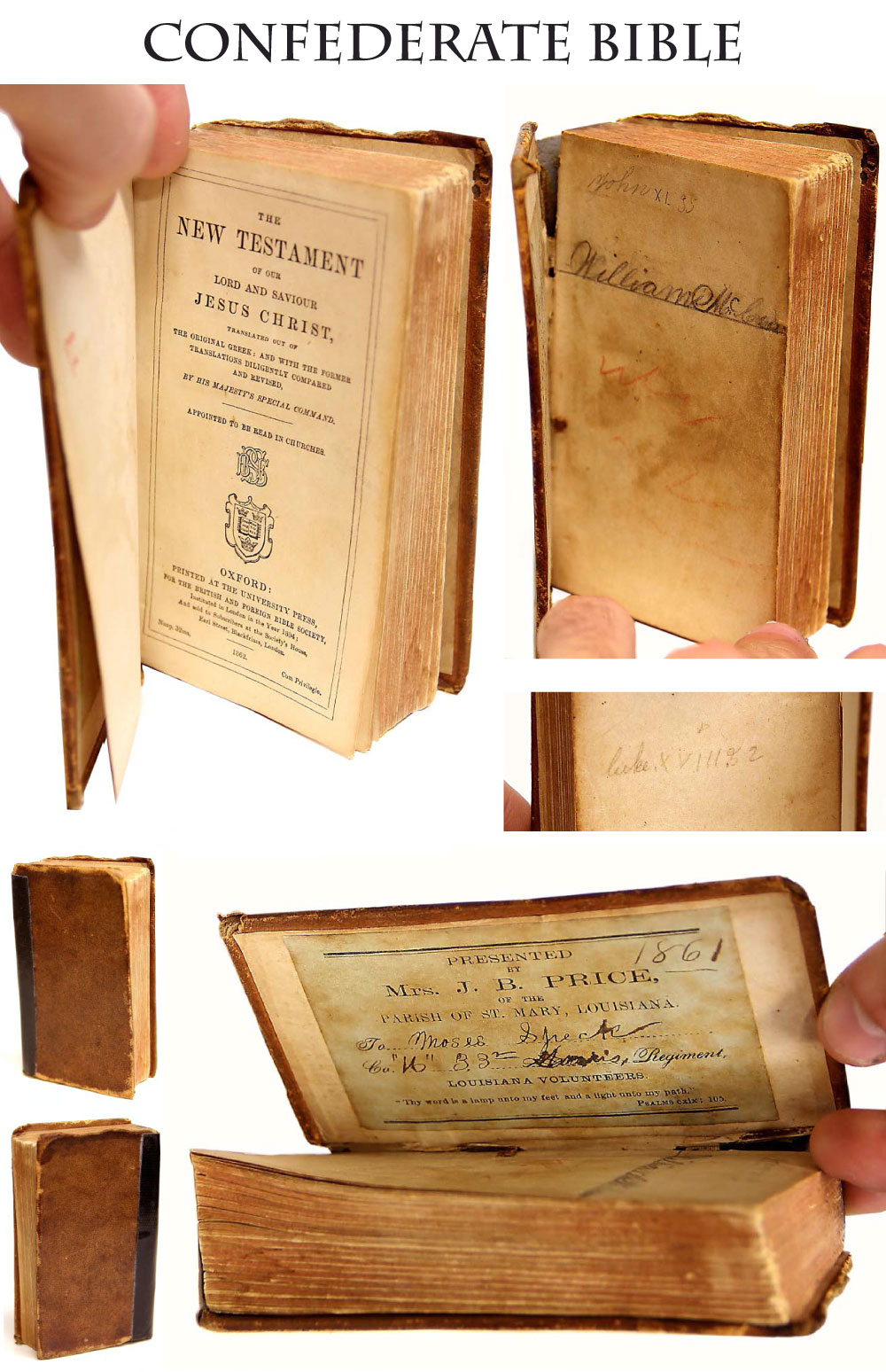
13-01-44 – Louisiana Confederate Soldier�s Testament w/ Magnificent Presentation Label:��
A wonderfully visual display item.� As you can see the Testament was given by a Louisiana lady of obvious Confederate loyalties, to a soldier named Moses Speck in the 33rd�Louisiana Regiment.� I will give data on the unit below.� I can find no roster for the 33rd�and assume those Confederate records are lost to the ages.� Interestingly — penciled on the next page is the name William McCra?� The data page shows Louisiana soldiers with the last name McCrary� McCraw McCronklin and McCrory.�� I believe the name written on the page is McCraw, and this name does show up in Louisiana records.�� William McCraw was a corporal in the 19th�Louisiana which like the 33rd�was part of Mouton�s Brigade in 1862.� The Testament is tight and solid.� Has a 20th�century repair to the spine.� Like most Confederate Testaments this one was published in Oxford,� England and run through the blockade.� It bears an 1862 date on the title page.
Following is information gleaned from�
www.louisianacivilwar.org
.
General Alfred Mouton’s Brigade consisted of, off-and-on, of the following regiments: 18th Louisiana, 24th Louisiana and 28th Louisiana. Unit names common to see in the history of Mouton’s Brigade were the following: 10th Louisiana Battalion (Yellow Jacket Battalion), 11th Louisiana Battalion, 12th Louisiana Battalion (Confederate Guards Response Battalion), and 33rd Louisiana Regiment. Also, you will come across the Consolidated 18th Regiment and Yellow Jacket Battalion and the Consolidated Crescent Regiment. This is very confusing and I’ll attempt to break down this confusing set up for you and track the progression of Mouton’s Brigade.
When Mouton returned to duty his command included the 18th Regiment, newly reformed 24th Regiment and the newly created�33rd Louisiana Regiment. The 33rd Regiment “enjoyed” an extremely brief life. It was created on October 10th 1862 near Donaldsonville. It was created by the consolidation of the 10th Louisiana Battalion and 12th Louisiana Battalion. It fought in one battle, Battle of Georgia Landing, and appears to have conducted itself unfavorably. There were problems between the two units consolidating into one regiment and on November 23rd Taylor disbanded the regiment back into its two distintive battalions. The battalions, though, are of special interest to the history of Mouton’s Brigade.
The�
12th Louisiana Battalion
�is also known as Clack’s Battalion and the Confederate Guards Response Battalion. This unit was originally organized in New Orleans as the Confederate Guards Response Battalion. It formed in March of 1862 for 90 Days with two companies. It served in the Army of the Mississippi, fought at Shiloh, served in the Siege of Corinth and disbanded at Tupelo at the end of its service (July). It reorganized itself at New Iberia in August, with a third company added soon afterwards. After its brief role in the 33rd Louisiana it remained an independent Battalion, fighting in the Battles of Irish Bend and Bayou Fordoche. When the army returned to south Louisiana, Clack’s Battalion was attached to Mouton’s Brigade in August.
The other battalion used to create the 33rd Regiment was the�
10th Louisiana Battalion
�or better known as the Yellow Jacket Battalion. This battalion was formed in St. Martinville in April of 1862 under the command of Antoine Fournet and thus it was commonly known as Fournet’s Battalion. It operated in South Louisiana during late 1862 and was merged with the 12th Battalion in October to form the 33rd Regiment. After the break up of that regiment the battalion fought at Bisland and Irish Bend. Although it operated with the army during 1863 a large percentage of the regiment deserted when the army left the Teche Region. It was mounted and hunted Jayhawkers through the Summer. Once the battalion reconstituted itself at Vermillionville it joined Mouton’s Brigade in September of 1863.
Wonderful Confederate Personal Item���
SOLD
Click Here to E-mail Us!
Call us @ 419-842-1863

13-01-45 – Cavalry Tactics Manual- Many times rarer, and more sought after, than the comparable infantry manuals:
The Instruction, Formations, and Movements of The Cavalry of the Army and Volunteers of the United States. By Col. Philip St. Geo. Cooke, 2nd U.S. Cavalry VOL. 1. Washington: Government Printing Office, 1861.
This is the basic cavalry manual introduced at the beginning of the war and includes the school of the trooper, the platoon and squadron, drills and tactics both on foot and mounted, forming column and line, wheeling, the manual of arms, skirmishing, etc., etc. If you are interested in Civil War cavalry (and who can�t be?), this is a key reference book and would look great in any display of cavalry gear.
Cooke was an old-army cavalryman, having graduating West Point in 1827 and serving in the dragoons in the Black Hawk War, the Mexican War, and a number of fights with Indians on the plains as well as peacekeeping in Utah and Kansas. During the Civil War he commanded the brigade of regular cavalry in the Army of the Potomac and the Cavalry Reserve before being moved into more administrative posts. A Virginian by birth, his son joined the Confederacy, as did his famous son-in-law: Jeb Stuart, whose successful exploits may have played a part his father-in-law�s reassignment.
This is a fairly tight copy, all pages present, with some use but not abuse. There are some pencil notations in it that might lead to an identification of the owner if deciphered correctly- I don�t have the time to pursue it fully. One seems to be the name Arthur Mc- something from Beallsville Ohio, Monroe County. Another is a postwar pencil inscription from Lewis Seikert of Lebanon, Ohio. My guess would be they are related and some sleuthing might yield some interesting history. In any case, this is a scarce pocket volume that would be carried in the saddle bags of just about every aspiring cavalier in the early years of the war.
$225.00 SOLD
Click Here to E-mail Us!
Call us @ 419-842-1863
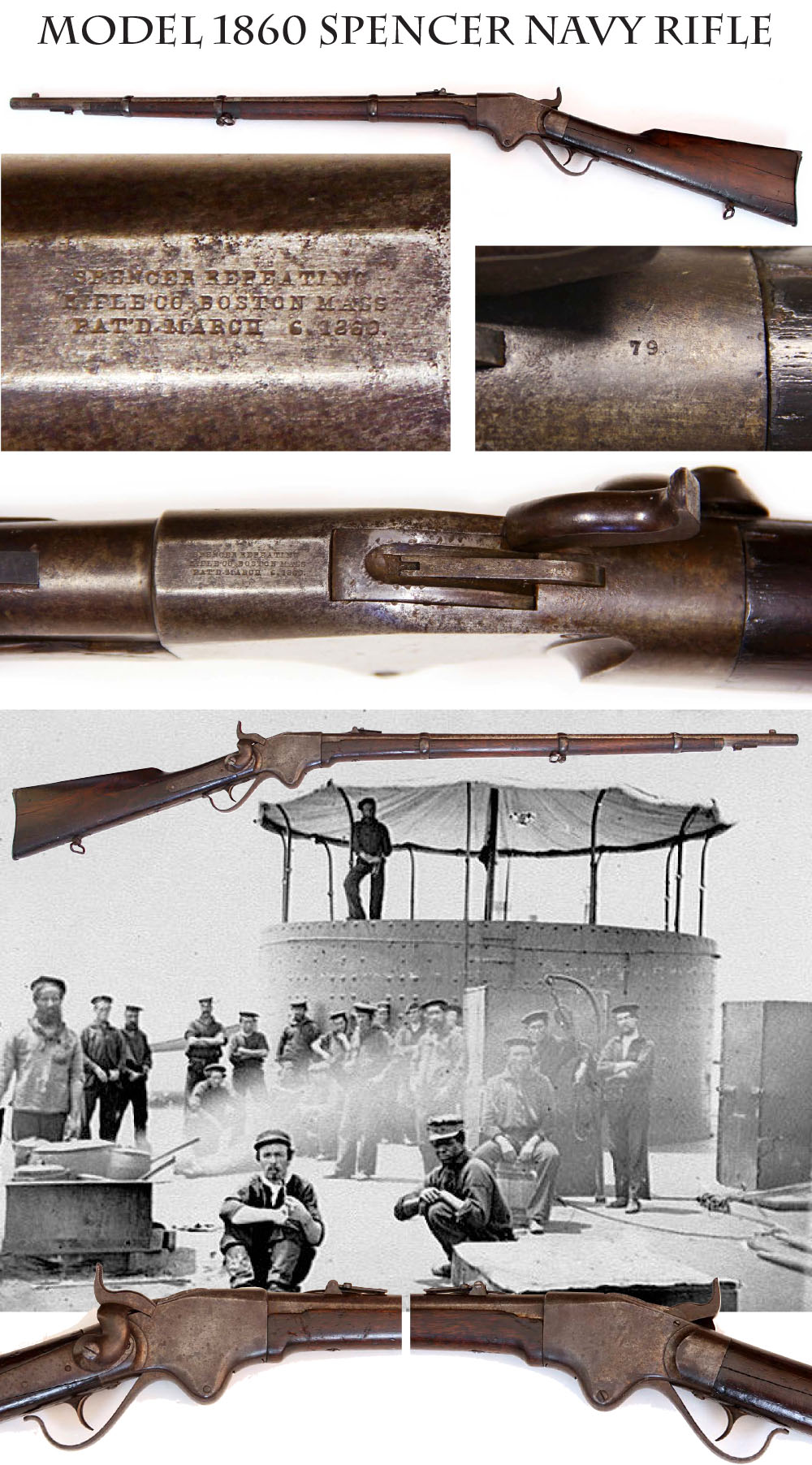
13-01-46 – Spencer Navy Rifle Serial Number 79:
Manufactured circa 1862. Records show that only 709 of these rifles were made in this Navy pattern and all were delivered to the US Navy Yard. (Another source states 1000 navy rifles were produced, but that is an estimate.) The top of the receiver is marked “SPENCER REPEATING/RIFLE CO. BOSTON MASS/PAT’D MARCH 6, 1860” and the serial number 79 is marked on the top rear of the receiver where it meets the wrist. This is the lowest serial number I have seen on a Spencer rifle� Rear sight graduated to 800 yards. The distinctive feature of the Navy rifle is the barrel being fitted with a bayonet lug on the underside of the muzzle for attachment of a saber bayonet. These navy rifles are beyond scarce, they are downright rare, with upper condition examples bringing in the range of twenty thousand dollars. This specimen is overall �very good� condition. All metal is smooth with a uniform delicate blue-grey patina� very attractive, honest, and untouched. All metal markings are crisp and legible. The stock has expected bumps and bruises and some ancient stress cracks in the butt stock, (see pictures), but it is very solid and presentable. There are a couple chips in the forearm that the photos illustrate accurately. I haven�t owned a Spencer navy rifle in years and am glad to have this one to offer. It surfaced in SW Michigan. A must for the Spencer collector, Civil War arms collector, and Navy collector. With the serial number of 79 we can be sure this rifle was produced during the first week of production and perhaps the first day of production �
$4,950.00
Click Here to E-mail Us!
Call us @ 419-842-1863
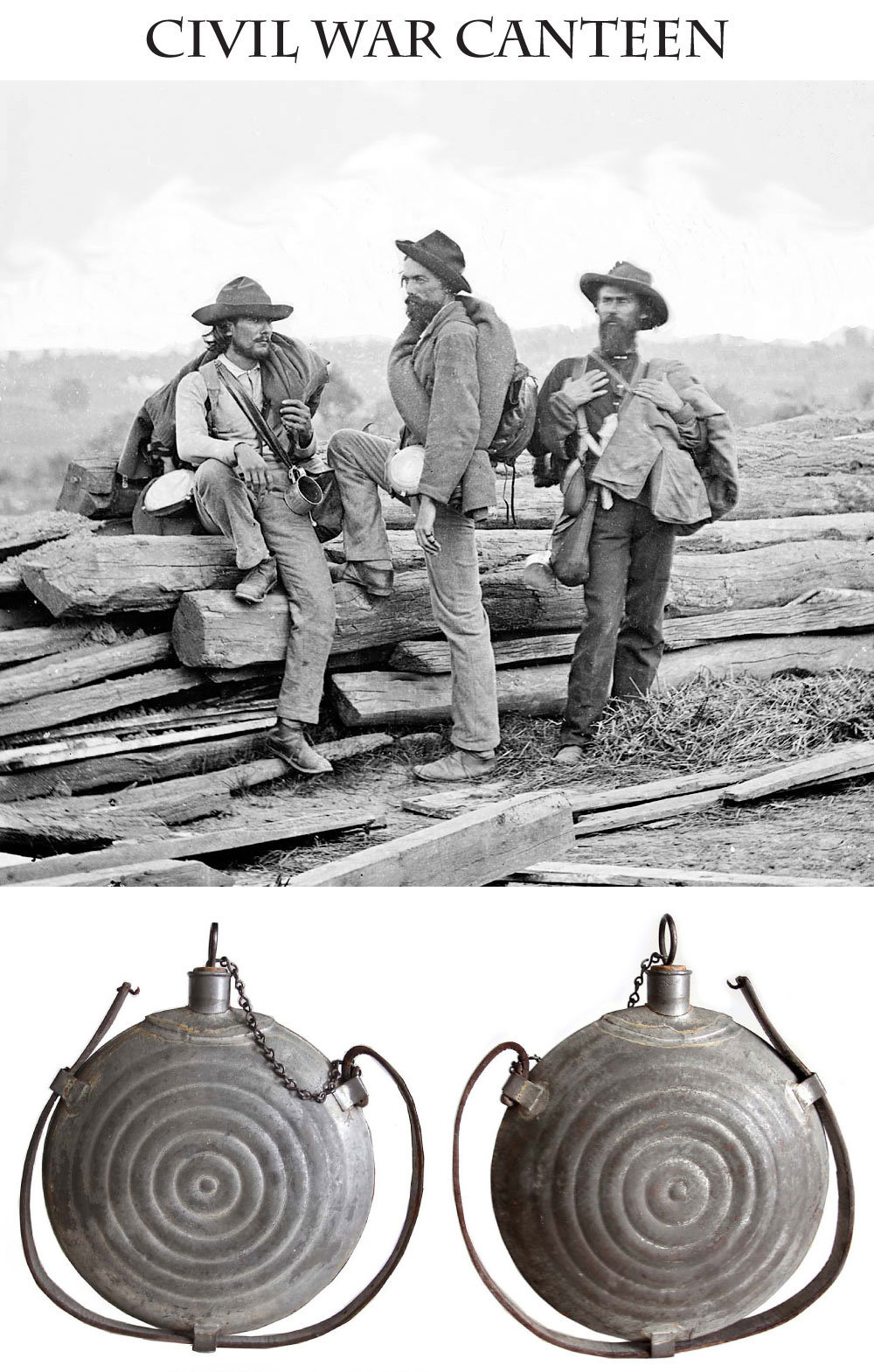
13-01-47 – Civil War Bullseye Canteen:
This is the standard bullseye canteen in Very good condition. The rings were believed to add strength to the canteen but such did not prove to be the case, so the government went back to all smooth side canteens for the remainder of the 19th century. The Philadelphia depot started issuing bullseye canteens in 1862, and the famous photo of the Confederate prisoners at Gettysburg clearly shows one of the Reb�s with a bullseye. Overall fine condition with remnants of the strap, the original stopper and original chain.�
$225.00 SOLD
Click Here to E-mail Us!
Call us @ 419-842-1863

13-01-48 – Sharps Four Barrel Pepperbox:�
22 caliber, overall VG, mechanically perfect. Some pitting on right side of the barrels, otherwise fine.� I�ll let the pictures tell the rest.
$550.00
Click Here to E-mail Us!
Call us @ 419-842-1863

13-01-49 – Remington Beals Army Revolver:
One of the more elusive Civil War revolvers is this 44 caliber Beals Army. Current wisdom states that 1,850 of these were produced, but I have seen the quantity estimated at 2,000 and 3,000 over the years. According to the book
Remington Handguns
by Charles L. Karr, South Carolina purchased a thousand Beals army revolvers in 1860. However a new book
Remington Army & Navy Revolvers
by Donald Ware states that there is no such record and Ware further goes on to state that the Beals Army wasn�t produced until 1862. This statement is something I cannot reconcile in my own head because the Beals revolvers preceded the Elliot �old models� and the Elliots bear December 1861 patent dates and were produced in 1862. I wish Karr had footnoted his South Carolina report and I wish Ware had explained why he feels Beals were produced at the same time as the Elliots� but all I can do is report what the experts are currently stating. All my life we have believed half the production went south. Gun is overall VG approaching fine condition. Steel is a very attractive plum patina with rumors of finish in protected areas. All markings are crisp and legible, though the bottom line of the barrel legend was struck slightly weakly. Grips are fine+. Action is crisp and strong. 100% original 100% complete mechanically perfect. Serial number 287. Top notch example of a rare Civil War revolver.
$2,450.00 SOLD
Click Here to E-mail Us!
Call us @ 419-842-1863
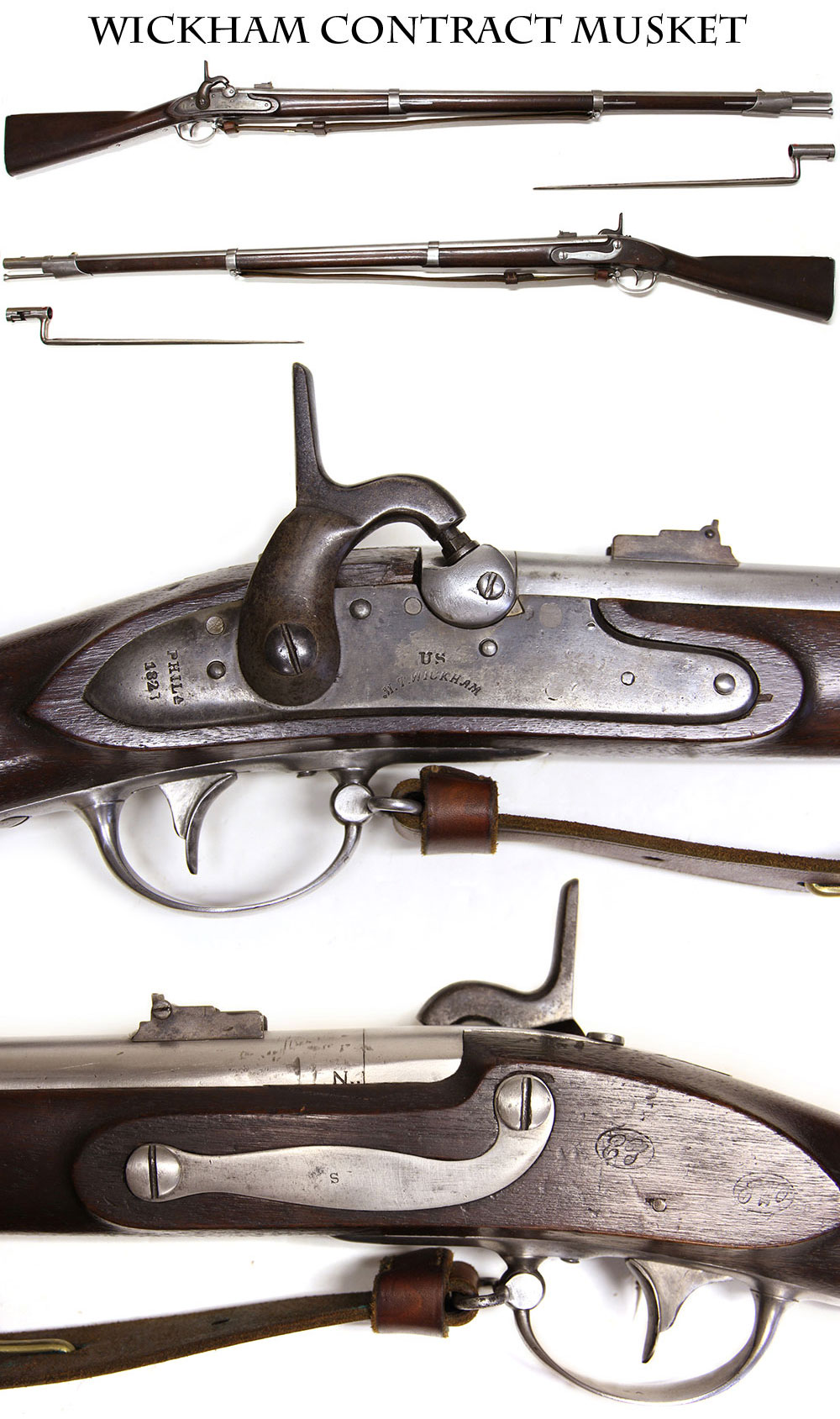
13-01-50 – H&P Conversion of M-1816 Wickham Contract Musket For State of New Jersey:
This is a type-1 Hewes and Phillips conversion with the replacement breech which has the bolster with a cleanout screw. (The later examples do not have the screw.) Overall VG++ condition. 100% original, 100% complete, and mechanically perfect. The lock is marked �US M. T. Wickham� forward of the hammer, and �Phila 1827� behind the hammer. Barrel, bands, and ramrod are overall clean steel. The lock retains some smoky case color and has a grey patina. The wood is very good to fine with VG edges and wonderful color. Two inspectors� cartouches are clearly legible on the stock opposite the lock. Left breech is stamped �NJ� for New Jersey. Rear sight is early style 1855-61 pattern mounted in reverse as is correct for these conversions. 8000 of these type-1 conversions were made, making them a rather scarce Civil War longarm. Most of the type 1 guns went to New Jersey troops. A very appealing early war weapon with strong condition. Comes with a perfect replica brown leather rifle sling.
$1,750.00 (ts285)
Bayonet for the above gun. Fine condition bayonet with 1855 style rounded shoulders on the blade and 1816 style socket. A very scarce bayonet these days. Bayonet is fine+ condition with bright steel and clear US stamp on the blade.
$195.00 (ts283) SOLD
Click Here to E-mail Us!
Call us @ 419-842-1863

13-01-51 – 1861 Dated Enfield Rifle:
Standard English P53 Enfield in attic brown condition. The pictures tell the story. Overall VG showing honest age. Lacks a main spring in the lock, otherwise 100% original and complete. Must be some dust or dirt in the ramrod channel as the rod sticks out a couple inches. Easily remedied. Just bought it right and will flip-it right�
$1,050.00 SOLD
Click Here to E-mail Us!
Call us @ 419-842-1863

13-01-52 – North Carolina Battlefield Walking Stick: �
A fine early battlefield souvenir with inscribed silver cap circa 1900.� The silver cap is marked in classic 1890-1910 fashion� � Edward P. Smith Co. E� 44th�Regt. MVM /� Rawles Mills NC� Nov. 2, 1862.� �Rawle�s Mills was the first battle action seen by the 44th.� �Here is a recap of the regiment�s service�� Expedition from Newberne November 2-12, 1862. �
Action at Rawle’s Mills November 2.
���Demonstration �Newberne November 11. Foster’s Expedition to Goldsboro December 11-20. Kinston December 14. Whitehall December 16. Goldsboro December 17. �At Newberne until February 10, 1863. Moved to Plymouth, N. C., February 10, and duty there until March 15. (Cos. “B” and “F” detached on outpost duty at Batchelor’s Creek February 10 to May 1.) Skirmishes Deep Gully, �Newberne, March 13-14 (2 Cos.). Regiment moved to Washington March 15. Siege of Washington March 30-April 20. Skirmish at Washington March 30 (Cos. “A” and “G”). Skirmishes at Washington April 3 and 15. Expedition from Newberne to relief of Little Washington April 7-10 (2 Cos.). Regiment moved to Newberne April 22-24, and duty there until June 6. Expedition toward Kinston April 27-May 1. Dover Road April 28. Moved to Boston, Mass., June 6-10. Mustered out June 18, 1863.� Undoubtedly soldier Smith returned to the early battlefield in his later years, �clipped a branch from a battlefield tree, and manufactured himself a fine walking stick.� Nice piece of veteran�s folk art. D-rp �
$450.00 SOLD
Layaways are Welcome
Need to split your order into multiple payments? No problem! A simple 20% earnest money deposit will hold your item for you.-acf
You can then pay it off in easy installments that fit your budget.
Read Terms Here
Items to Sell? Contact Us
I am always interested in buying ANYTHING from the American Civil War… Guns, Swords, Civil War Muskets, Knives, Uniforms, Flags, Medals, Badges, Diaries, Letters, Autographs, Buttons, photographs, tintypes, daguerreotypes, Insignia, Camp Items, Battlefield Relics, canteens, Drums, Etc… Call 419-842-1863 and ask for Dave Taylor.

